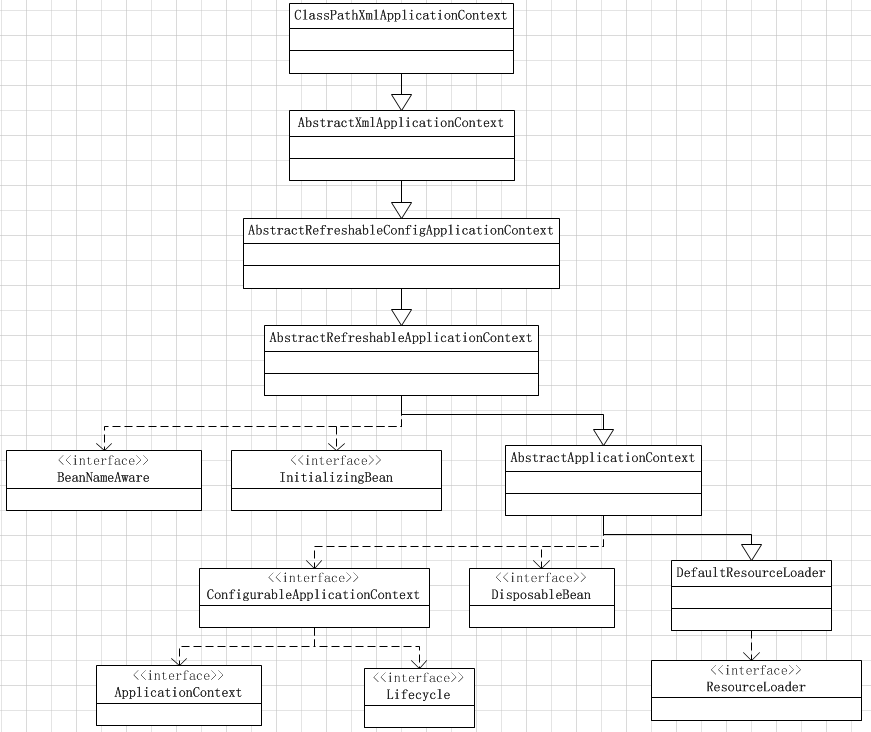Spring的加载过程相对是不太透明的,不太好去找加载的代码入口。
下面有很简单的一段代码可以作为Spring代码加载的入口:
ApplicationContext ac = new ClassPathXmlApplicationContext("classpath:applicationContext.xml"); AServiceImpl targetClass=(AServiceImpl)ac.getBean("aService"); System.out.println(targetClass);
ClassPathXmlApplicationContext用于加载CLASSPATH下的Spring配置文件,可以看到,第二行就已经可以获取到Bean的实例了,那么必然第一行就已经完成了对所有Bean实例的加载,因此可以通过ClassPathXmlApplicationContext作为入口。为了后面便于代码阅读,先给出一下ClassPathXmlApplicationContext这个类的继承关系:
ClassPathXmlApplicationContext存储内容
为了更理解ApplicationContext,拿一个实例ClassPathXmlApplicationContext举例,看一下里面存储的内容,加深对ApplicationContext的认识,以表格形式展现:
| 对象名 | 类 型 | 作 用 | 归属类 |
| configResources | Resource[] | 配置文件资源对象数组 | ClassPathXmlApplicationContext |
| configLocations | String[] | 配置文件字符串数组,存储配置文件路径 | AbstractRefreshableConfigApplicationContext |
| beanFactory | DefaultListableBeanFactory | 上下文使用的Bean工厂 | AbstractRefreshableApplicationContext |
| beanFactoryMonitor | Object | Bean工厂使用的同步监视器 | AbstractRefreshableApplicationContext |
| id | String | 上下文使用的唯一Id,标识此ApplicationContext | AbstractApplicationContext |
| parent | ApplicationContext | 父级ApplicationContext | AbstractApplicationContext |
| beanFactoryPostProcessors | List<BeanFactoryPostProcessor> | 存储BeanFactoryPostProcessor接口,Spring提供的一个扩展点 | AbstractApplicationContext |
| startupShutdownMonitor | Object | refresh方法和destory方法公用的一个监视器,避免两个方法同时执行 | AbstractApplicationContext |
| shutdownHook | Thread | Spring提供的一个钩子,JVM停止执行时会运行Thread里面的方法 | AbstractApplicationContext |
| resourcePatternResolver | ResourcePatternResolver | 上下文使用的资源格式解析器 | AbstractApplicationContext |
| lifecycleProcessor | LifecycleProcessor | 用于管理Bean生命周期的生命周期处理器接口 | AbstractApplicationContext |
| messageSource | MessageSource | 用于实现国际化的一个接口 | AbstractApplicationContext |
| applicationEventMulticaster | ApplicationEventMulticaster | Spring提供的事件管理机制中的事件多播器接口 | AbstractApplicationContext |
| applicationListeners | Set<ApplicationListener> | Spring提供的事件管理机制中的应用监听器 | AbstractApplicationContext |
ClassPathXmlApplicationContext构造函数
public ClassPathXmlApplicationContext(String[] configLocations, boolean refresh, ApplicationContext parent) throws BeansException { super(parent); setConfigLocations(configLocations); if (refresh) { refresh(); } }
public ClassPathXmlApplicationContext(String[] paths, Class<?> clazz, ApplicationContext parent) throws BeansException { super(parent); Assert.notNull(paths, "Path array must not be null"); Assert.notNull(clazz, "Class argument must not be null"); this.configResources = new Resource[paths.length]; for (int i = 0; i < paths.length; i++) { this.configResources[i] = new ClassPathResource(paths[i], clazz); } refresh(); }
从第二段代码看,总共就做了三件事:
1、super(parent)
没什么太大的作用,设置一下父级ApplicationContext,这里是null
2、setConfigLocations(configLocations)
代码就不贴了,一看就知道,里面做了两件事情:
(1)将指定的Spring配置文件的路径存储到本地
(2)解析Spring配置文件路径中的${PlaceHolder}占位符,替换为系统变量中PlaceHolder对应的Value值,System本身就自带一些系统变量比如class.path、os.name、user.dir等,也可以通过System.setProperty()方法设置自己需要的系统变量
3、refresh()
这个就是整个Spring Bean加载的核心了,它是ClassPathXmlApplicationContext的父类AbstractApplicationContext的一个方法,顾名思义,用于刷新整个Spring上下文信息,定义了整个Spring上下文加载的流程。
refresh方法
上面已经说了,refresh()方法是整个Spring Bean加载的核心,因此看一下整个refresh()方法的定义:
@Override public void refresh() throws BeansException, IllegalStateException { synchronized (this.startupShutdownMonitor) { // Prepare this context for refreshing. prepareRefresh(); // Tell the subclass to refresh the internal bean factory. ConfigurableListableBeanFactory beanFactory = obtainFreshBeanFactory(); // Prepare the bean factory for use in this context. prepareBeanFactory(beanFactory); try { // Allows post-processing of the bean factory in context subclasses. postProcessBeanFactory(beanFactory); // Invoke factory processors registered as beans in the context. invokeBeanFactoryPostProcessors(beanFactory); // Register bean processors that intercept bean creation. registerBeanPostProcessors(beanFactory); // Initialize message source for this context. initMessageSource(); // Initialize event multicaster for this context. initApplicationEventMulticaster(); // Initialize other special beans in specific context subclasses. onRefresh(); // Check for listener beans and register them. registerListeners(); // Instantiate all remaining (non-lazy-init) singletons. finishBeanFactoryInitialization(beanFactory); // Last step: publish corresponding event. finishRefresh(); } catch (BeansException ex) { logger.warn("Exception encountered during context initialization - cancelling refresh attempt", ex); // Destroy already created singletons to avoid dangling resources. destroyBeans(); // Reset 'active' flag. cancelRefresh(ex); // Propagate exception to caller. throw ex; } finally { // Reset common introspection caches in Spring's core, since we // might not ever need metadata for singleton beans anymore... resetCommonCaches(); } } }
每个子方法的功能之后一点一点再分析,首先refresh()方法有几点是值得我们学习的:
1、方法是加锁的,这么做的原因是避免多线程同时刷新Spring上下文
2、尽管加锁可以看到是针对整个方法体的,但是没有在方法前加synchronized关键字,而使用了对象锁startUpShutdownMonitor,这样做有两个好处:
(1)refresh()方法和close()方法都使用了startUpShutdownMonitor对象锁加锁,这就保证了在调用refresh()方法的时候无法调用close()方法,反之亦然,避免了冲突
(2)另外一个好处不在这个方法中体现,但是提一下,使用对象锁可以减小了同步的范围,只对不能并发的代码块进行加锁,提高了整体代码运行的效率
3、方法里面使用了每个子方法定义了整个refresh()方法的流程,使得整个方法流程清晰易懂。这点是非常值得学习的,一个方法里面几十行甚至上百行代码写在一起,在我看来会有三个显著的问题:
(1)扩展性降低。反过来讲,假使把流程定义为方法,子类可以继承父类,可以根据需要重写方法
(2)代码可读性差。很简单的道理,看代码的人是愿意看一段500行的代码,还是愿意看10段50行的代码?
(3)代码可维护性差。这点和上面的类似但又有不同,可维护性差的意思是,一段几百行的代码,功能点不明确,不易后人修改,可能会导致“牵一发而动全身”
prepareRefresh方法
下面挨个看refresh方法中的子方法,首先是prepareRefresh方法,看一下源码:
/** * Prepare this context for refreshing, setting its startup date and * active flag as well as performing any initialization of property sources. */ protected void prepareRefresh() { this.startupDate = System.currentTimeMillis(); this.active.set(true); if (logger.isInfoEnabled()) { logger.info("Refreshing " + this); } // Initialize any placeholder property sources in the context environment initPropertySources(); // Validate that all properties marked as required are resolvable // see ConfigurablePropertyResolver#setRequiredProperties getEnvironment().validateRequiredProperties(); // Allow for the collection of early ApplicationEvents, // to be published once the multicaster is available... this.earlyApplicationEvents = new LinkedHashSet<ApplicationEvent>(); }
这个方法功能比较简单,顾名思义,准备刷新Spring上下文,其功能注释上写了:
1、设置一下刷新Spring上下文的开始时间
2、将active标识位设置为true
另外可以注意一下12行这句日志,这句日志打印了真正加载Spring上下文的Java类。
obtainFreshBeanFactory方法
obtainFreshBeanFactory方法的作用是获取刷新Spring上下文的Bean工厂,其代码实现为:
protected ConfigurableListableBeanFactory obtainFreshBeanFactory() { refreshBeanFactory(); ConfigurableListableBeanFactory beanFactory = getBeanFactory(); if (logger.isDebugEnabled()) { logger.debug("Bean factory for " + getDisplayName() + ": " + beanFactory); } return beanFactory; }
其核心是第二行的refreshBeanFactory方法,这是一个抽象方法,有AbstractRefreshableApplicationContext和GenericApplicationContext这两个子类实现了这个方法,看一下上面ClassPathXmlApplicationContext的继承关系图即知,调用的应当是AbstractRefreshableApplicationContext中实现的refreshBeanFactory,其源码为:
@Override protected final void refreshBeanFactory() throws BeansException { if (hasBeanFactory()) { destroyBeans(); closeBeanFactory(); } try { DefaultListableBeanFactory beanFactory = createBeanFactory(); beanFactory.setSerializationId(getId()); customizeBeanFactory(beanFactory); loadBeanDefinitions(beanFactory); synchronized (this.beanFactoryMonitor) { this.beanFactory = beanFactory; } } catch (IOException ex) { throw new ApplicationContextException("I/O error parsing bean definition source for " + getDisplayName(), ex); } }
这行点出了DefaultListableBeanFactory这个类,这个类是构造Bean的核心类,这个类的功能会在下一篇文章中详细解读,首先给出DefaultListableBeanFactory的继承关系图
| 对象名 | 类 型 | 作 用 | 归属类 |
| aliasMap | Map<String, String> | 存储Bean名称->Bean别名映射关系 | SimpleAliasRegistry |
| singletonObjects | Map<String, Object> | 存储单例Bean名称->单例Bean实现映射关系 | DefaultSingletonBeanRegistry |
| singletonFactories | Map<String, ObjectFactory> | 存储Bean名称->ObjectFactory实现映射关系 | DefaultSingletonBeanRegistry |
| earlySingletonObjects | Map<String, Object> | 存储Bean名称->预加载Bean实现映射关系 | DefaultSingletonBeanRegistry |
| registeredSingletons | Set<String> | 存储注册过的Bean名 | DefaultSingletonBeanRegistry |
| singletonsCurrentlyInCreation | Set<String> | 存储当前正在创建的Bean名 | DefaultSingletonBeanRegistry |
| disposableBeans | Map<String, Object> | 存储Bean名称->Disposable接口实现Bean实现映射关系 |
DefaultSingletonBeanRegistry |
| factoryBeanObjectCache | Map<String, Object> | 存储Bean名称->FactoryBean接口Bean实现映射关系 | FactoryBeanRegistrySupport |
| propertyEditorRegistrars | Set<PropertyEditorRegistrar> | 存储PropertyEditorRegistrar接口实现集合 | AbstractBeanFactory |
| embeddedValueResolvers | List<StringValueResolver> | 存储StringValueResolver(字符串解析器)接口实现列表 | AbstractBeanFactory |
| beanPostProcessors | List<BeanPostProcessor> | 存储 BeanPostProcessor接口实现列表 | AbstractBeanFactory |
| mergedBeanDefinitions | Map<String, RootBeanDefinition> | 存储Bean名称->合并过的根Bean定义映射关系 | AbstractBeanFactory |
| alreadyCreated | Set<String> | 存储至少被创建过一次的Bean名集合 | AbstractBeanFactory |
| ignoredDependencyInterfaces | Set<Class> | 存储不自动装配的接口Class对象集合 | AbstractAutowireCapableBeanFactory |
| resolvableDependencies | Map<Class, Object> | 存储修正过的依赖映射关系 | DefaultListableBeanFactory |
| beanDefinitionMap | Map<String, BeanDefinition> | 存储Bean名称-->Bean定义映射关系 | DefaultListableBeanFactory |
| beanDefinitionNames | List<String> | 存储Bean定义名称列表 | DefaultListableBeanFactory |
